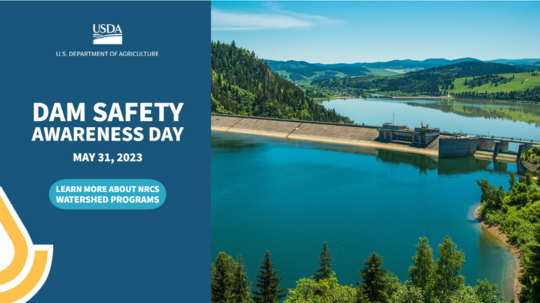
USDA helps producers prepare for and recover from natural disasters
Hurricane season is officially underway and lasts until November 30. The National Oceanic and Atmospheric Administration (NOAA) predicts that the 2023 hurricane season will be near normal in the Atlantic and produce 12 to 17 named storms, of which five to nine could become hurricanes, including one to four major hurricanes.
USDA encourages producers to prepare and protect their family and agricultural operations.
-
Develop an Emergency Plan - Ensure your household and employees know your hurricane plan, including meeting points, emergency contact lists, and alternate evacuation routes in case infrastructure is damaged.
-
Remove Debris and Secure Large Objects - Clean out culverts, ditches, and other drainage areas, especially before and during peak hurricane season to reduce water damage. Most injuries to animals, people, or structures during a hurricane are caused by flying objects. To lessen the risk, minimize the presence of equipment, supplies, and debris that may become airborne during high winds or encountered in floodwaters.
-
Secure Important Records and Documents- Pre- and post-hurricane documentation is extremely important for insurance compensation and recovery assistance. You’ll want to have thorough records of damages and losses sustained on your farm as well as documentation of your cleanup and recovery efforts.
- It is critical to document inventory of farm buildings, vehicles, equipment, and livestock before a disaster occurs. Take photos, videos, or make written lists with descriptions. Keep copies of this inventory in multiple places: computer, off-site in a safe location, and on a cloud-based server where information is transmitted and saved weekly.
-
Know Your Insurance Options- Regularly review your insurance policies with your agent to be sure you have adequate coverage, including flood insurance, for your facilities, vehicles, farm buildings, crops and livestock. Note, there are limitations on how soon insurance coverage will take effect. Generally, insurance policies will not cover damage if the policy was not in place before a disaster.
-
Gather Supplies - Have drinking water, canned food, a generator, batteries, a flashlight, and fuel available in case you lose power. For widespread outages, credit and debit cards may not work, so have cash handy.
-
Access Real-time Emergency Information- Download the FEMA app for free on the App Store and Google Play for safety tips on what to do before, during, and after disasters. Subscribe to our text message and email service to receive real-time, local operational and recovery information from the Farm Service Agency, Natural Resources Conservation Service and Risk Management Agency.
On farmers.gov, the Hurricane Webpage, Disaster Assistance Discovery Tool, Disaster-at-a-Glance fact sheet, and Loan Assistance Tool can help producers and landowners determine program or loan options. For assistance with a crop insurance claim, producers and landowners should contact their crop insurance agent. For FSA and NRCS programs, they should contact their local USDA Service Center.
|
 The U.S. Department of Agriculture (USDA) is investing $8 million in four partnerships to support and expand measurement and monitoring of carbon in soil on working agricultural lands and to assess how climate-smart practices are affecting carbon sequestration. USDA’s Natural Resources Conservation Service (NRCS) will work with Iowa State University, Michigan State University, American Climate Partners and University of Texas at El Paso on regional projects on soil organic carbon stock monitoring.
Learn more online.
 May 31 marked the anniversary of the South Fork Dam failure of 1889 that launched dam safety into national awareness. The day serves as a reminder to remain vigilant caretakers of the nation’s 84,000-plus dams.
Age affects the performance of everything, including watershed infrastructure. Attention and ongoing maintenance is the responsibility of both the dam owner and the community it serves — requiring a coordinated, collective effort to ensure dams continue to function as intended…as silent protectors. To help communities remain vigilant, USDA’s Natural Resources Conservation Service (NRCS) offers dam safety resources for communities.
Learn about NRCS’s role in dam safety.
 The USDA NRCS in Texas applications are by June 15, 2023 for new and additional fiscal year (FY) 2023 financial assistance opportunities for agricultural producers and landowners for Environmental Quality Incentives Program (EQIP). One of the new opportunities is the Migratory Bird Resurgence Initiative (MBRI), aimed at preserving, protecting and improving habitat for migratory waterfowl, shorebirds, neotropicals and other avian species in the Prairie Pothole Region and in key portions of the Pacific, Mississippi, and Central Flyways. The other new opportunity is the Organic Transition Initiative (OTI) which provides funding to support producers transitioning to organic production by providing financial assistance and technical assistance to implement conservation practices that support organic production. The OTI supports USDA’s objective of developing diverse and equitable food systems while encouraging climate-smart agriculture by focusing funds on transition producers to organic production.
Additional sign up have also been announced for National Air Quality Initiative (NAQI).
While NRCS accepts applications for these programs year-round, producers and landowners should apply by state-specific, application cutoff dates to be considered for fiscal year’s funding. Texas application cutoff date for MBRI, OTI, and NAQI will be June 15, 2023.
Learn more about these soil carbon stock monitoring projects online.
Are you an organic or transitioning producer looking for help from the U.S. Department of Agriculture (USDA)? In the past year, USDA has upped its investments for organic agriculture, including the new Organic Transition Initiative (OTI) that helped create new programs as well as bolster support for existing ones.
Learn more at our upcoming virtual webinar, taking place on June 6, 2023, at 1 p.m. (Central).
Topics will include:
- Assistance with certification costs
- Access to capital
- Assistance for dairy producers
- Technical and financial assistance for conservation practices
- Risk management options and benefits
- Changes for producers required by the Strengthening Organic Enforcement final rule
- New wrap-around support for transitioning and existing organic farmers
- New grant funding for organic processors and brands
RSVP for the Zoom event.
 |
|
Know someone looking for a career with NRCS Texas? Help us spread the word that we're hiring recent college graduates. We also have several direct hire positions advertised on www.usajobs.gov!
Current USDA NRCS Career Openings in Texas
Be sure to send folks to our Texas NRCS YouTube Channel, so they can hear from NRCS employees about careers with our agency!
|
|